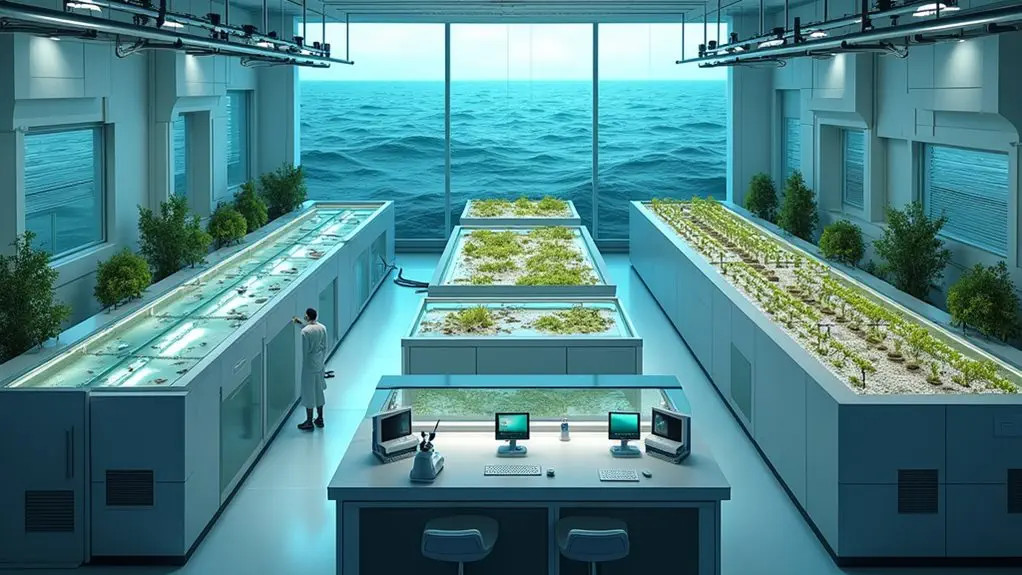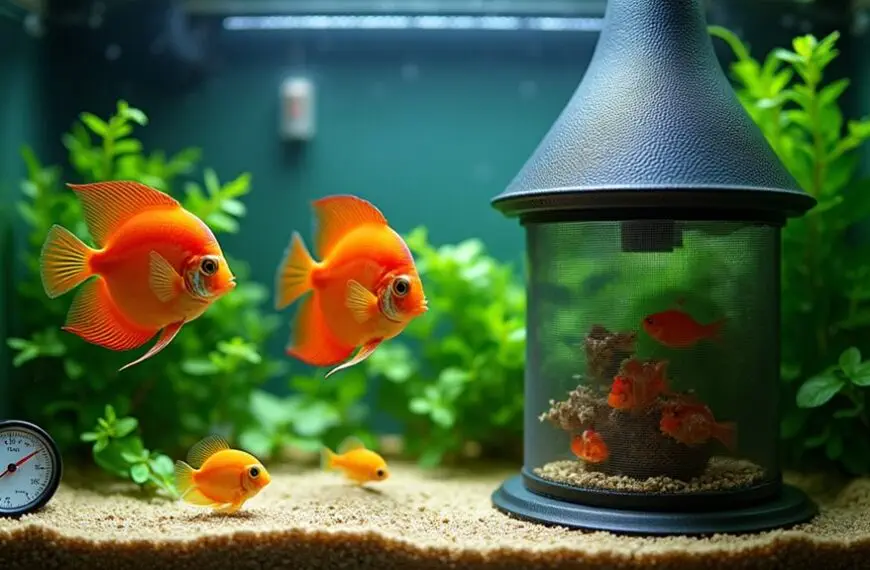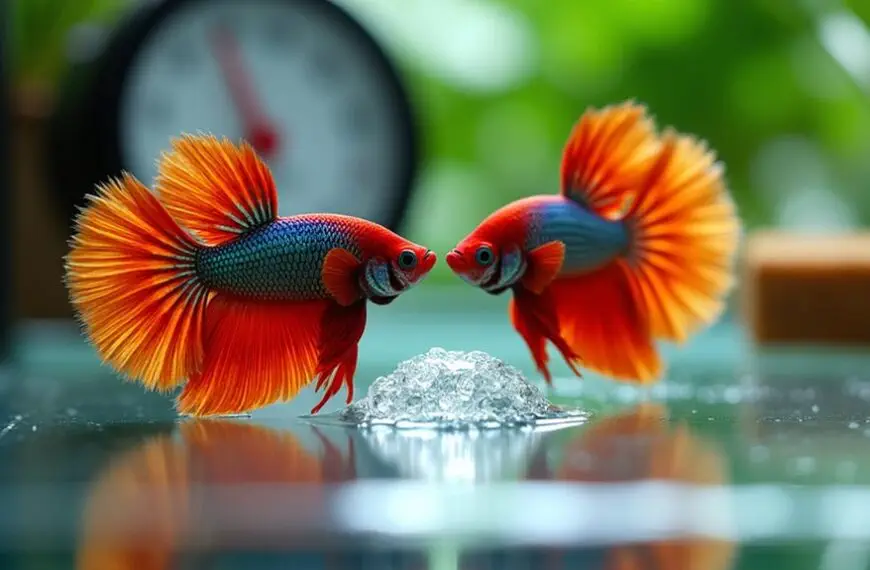In 2025, you'll find five innovative fish breeding methods transforming aquaculture. Recirculating Aquaculture Systems (RAS) reuse 99% of water through advanced filtration. Gene-edited selective breeding enhances growth and disease resistance using CRISPR technology. Biofloc systems employ microbial communities for natural filtration, reducing water usage by 90%. Integrated Multi-Trophic Aquaculture mimics natural ecosystems with multiple species. Offshore deep-water cages operate 20-50 meters below surface, minimizing coastal impact. Each approach offers unique sustainability benefits worth exploring further.
Contents
- 1 Recirculating Aquaculture Systems (RAS): The Zero-Waste Revolution
- 2 Gene-Edited Selective Breeding: Enhancing Growth and Disease Resistance
- 3 Biofloc Technology: Microorganism Communities as Natural Filtration
- 4 Integrated Multi-Trophic Aquaculture (IMTA): Symbiotic Ecosystem Approach
- 5 Offshore Deep-Water Cage Cultivation: The Frontier of Large-Scale Production
- 6 Frequently Asked Questions
- 6.1 What Licenses Are Required for Commercial Fish Breeding Operations?
- 6.2 How Do Breeding Methods Impact Fish Taste and Nutrition?
- 6.3 What Is the Average ROI Timeline for Each Breeding Method?
- 6.4 How Do Different Climates Affect Breeding Method Selection?
- 6.5 Which Breeding Methods Are Most Appropriate for Small-Scale Hobbyists?
- 7 Final Thoughts
Recirculating Aquaculture Systems (RAS): The Zero-Waste Revolution
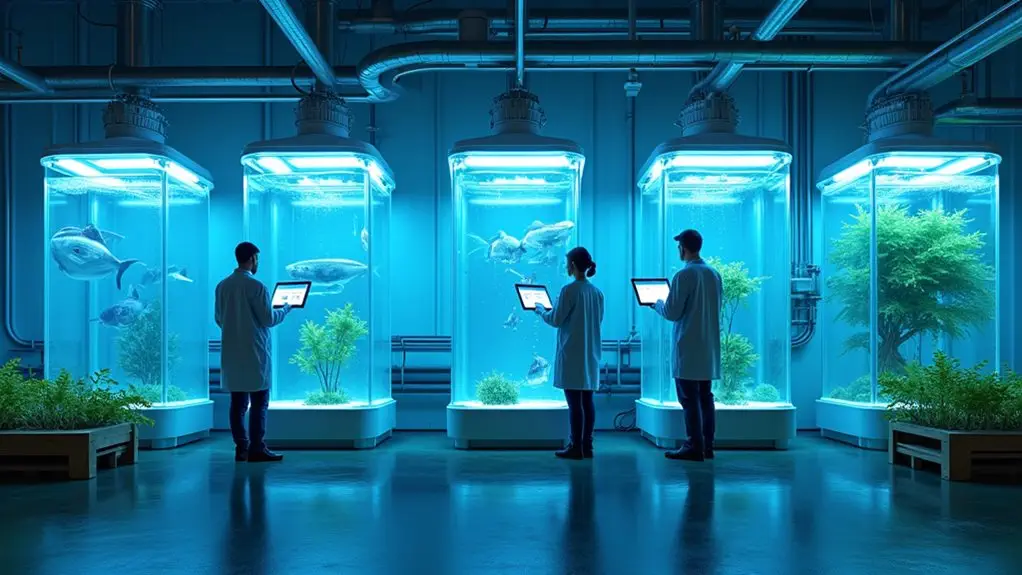
While traditional fish farming methods often waste resources and pollute waterways, Recirculating Aquaculture Systems (RAS) have emerged as revolutionary technology in sustainable fish breeding.
You'll find these closed-loop systems filter and reuse up to 99% of their water, dramatically reducing environmental impact compared to conventional methods.
RAS pioneers have implemented impressive sustainability practices that you can see throughout the process.
Water quality sensors monitor conditions in real-time, feeding systems dispense precise amounts to prevent waste, and biofilters remove harmful compounds naturally.
You're looking at energy efficiency too—modern RAS facilities now employ solar panels and heat exchangers to slash power consumption by nearly 40%.
What's most exciting is how these systems can operate virtually anywhere, from urban warehouses to desert regions, bringing fresh fish production closer to consumers.
Gene-Edited Selective Breeding: Enhancing Growth and Disease Resistance
Beyond water efficiency, today's fish breeding has entered an exciting new frontier with genetic advances that you've likely heard about in headlines.
Using gene editing technologies like CRISPR, breeders can now enhance selective traits without introducing foreign DNA into fish species. This isn't science fiction—it's happening right now in labs worldwide!
You'll find these methods create fish with improved growth rates, better feed conversion, and stronger disease resistance. The process targets specific genes already present in the fish, simply tweaking them for peak performance.
While traditional selective breeding took decades to see results, today's gene editing techniques yield improvements within a single generation.
It's a game-changer that's making sustainable aquaculture more viable and helping meet global protein demands without the environmental footprint of conventional farming.
Biofloc Technology: Microorganism Communities as Natural Filtration
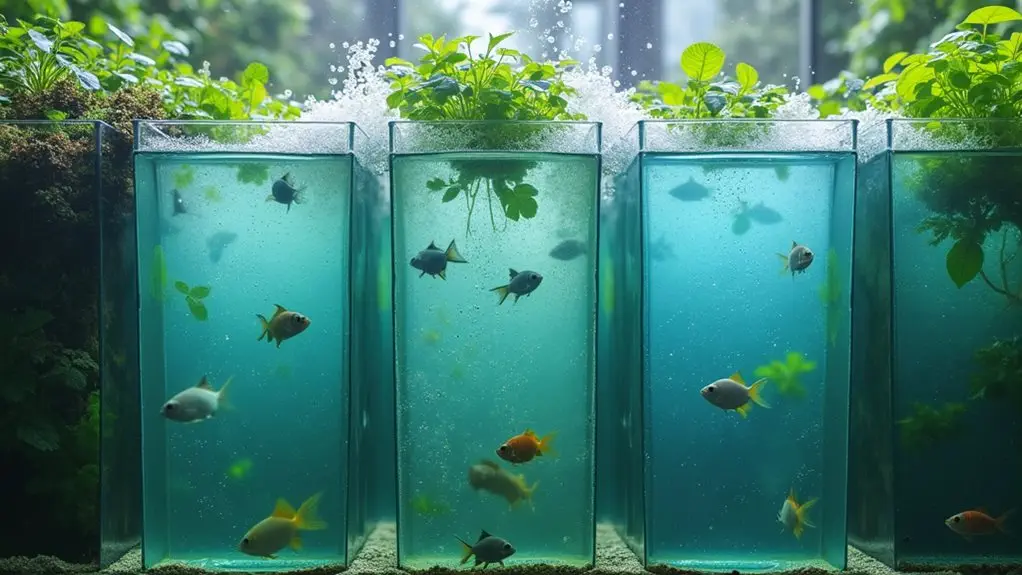
Since the emergence of sustainable aquaculture, biofloc technology has revolutionized how we're breeding fish today. This innovative approach utilizes microbial communities to create a natural filtration system right in your fish tanks.
You'll find that waste products are quickly converted into protein-rich food for your fish, creating a beautiful circular ecosystem.
The biofloc advantages are numerous—you'll reduce water usage by up to 90%, minimize disease outbreaks, and improve feed conversion rates. Your fish grow faster while consuming fewer resources!
Revolutionize your fish farm with biofloc technology—less water, fewer diseases, better growth, and improved sustainability.
The secret lies in the microbial diversity within the system, where beneficial bacteria, microalgae, and protozoa work together to maintain water quality.
You can easily start small with this technology, gradually scaling up as you become comfortable with managing the delicate microbial balance.
Integrated Multi-Trophic Aquaculture (IMTA): Symbiotic Ecosystem Approach
As we look toward the future of sustainable aquaculture, Integrated Multi-Trophic Aquaculture (IMTA) stands out as a game-changing approach you'll want to explore. This method mimics natural ecosystem balance by farming multiple species that work together symbiotically.
In IMTA systems, you'll find fish, shellfish, and seaweeds coexisting beautifully. The waste from your fish becomes fertilizer for seaweeds, while shellfish filter excess particles—creating a perfect nutrient cycling loop!
It's like having nature's cleanup crew working 24/7 in your farm. You'll love how IMTA reduces environmental impact while boosting your harvest diversity. Instead of fighting against natural processes, you're harnessing them!
Many commercial farms have reported up to 30% higher overall yields when switching to this harmonious approach.
Offshore Deep-Water Cage Cultivation: The Frontier of Large-Scale Production
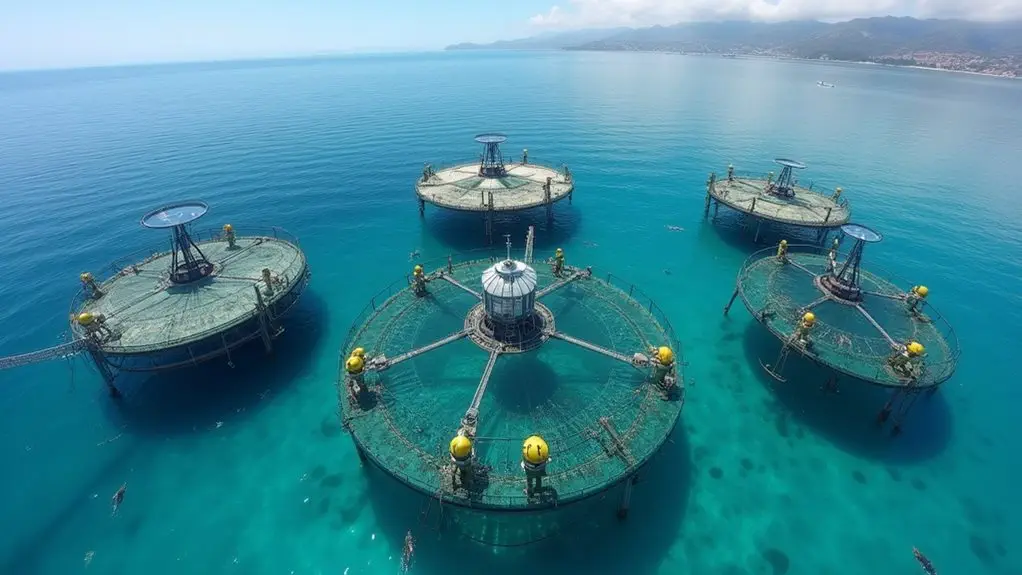
While IMTA systems brilliantly manage resources in controlled environments, the open ocean offers an exciting new frontier for fish production.
You'll find that offshore deep-water cultivation has revolutionized the industry by utilizing robust cage designs that withstand powerful currents and storms. These cages, often submerged 20-50 meters below the surface, create ideal growing conditions for many species.
Site selection is vital – you'll need locations with proper depth, current flow, and distance from shipping lanes.
Strategic offshore site selection ensures optimal fish health, operational efficiency, and navigational safety.
The beauty of offshore farming is how it reduces coastal environmental impacts while allowing fish to grow in more natural conditions. You're fundamentally mimicking their wild habitat!
Companies are now operating massive offshore farms in the Mediterranean, Gulf of Mexico, and South China Sea, producing thousands of tons of sea bass, tuna, and amberjack annually.
Frequently Asked Questions
What Licenses Are Required for Commercial Fish Breeding Operations?
You'll need aquaculture permits, water rights licenses, environmental compliance certifications, and business registrations. Licensing requirements vary by location, while regulatory compliance includes health standards, effluent regulations, and endangered species considerations.
How Do Breeding Methods Impact Fish Taste and Nutrition?
Like a chef's secret ingredients, your breeding methods directly shape taste profiles and nutritional value. You'll notice wild-caught flavors differ from farm-raised, while feed quality and water conditions greatly impact the nutrients you'll consume.
What Is the Average ROI Timeline for Each Breeding Method?
You'll find ROI timelines vary: selective breeding (3-5 years), recirculating systems (2-3 years), pond culture (1-2 years), cage farming (2-4 years), and hatcheries (3-6 years). Your investment strategies should include thorough ROI analysis when choosing.
How Do Different Climates Affect Breeding Method Selection?
Like choosing the perfect soil for a garden, your breeding method hinges on climate adaptation. You'll need stronger temperature regulation systems in extreme climates, while moderate regions offer more flexibility in your selection approach.
Which Breeding Methods Are Most Appropriate for Small-Scale Hobbyists?
You'll find selective breeding, bubble nest building, and spawning mops most accessible for your home aquarium setups. Don't overlook live food cultivation and simple tank division as beginner-friendly breeding techniques that require minimal equipment.
Final Thoughts
You've now seen how fish farming's evolving beyond traditional methods. Like a phoenix rising from water, these five breeding approaches represent aquaculture's rebirth in 2025. Whether you're fascinated by RAS's zero-waste solutions or intrigued by gene-editing's potential, you're witnessing a sea change. These innovations aren't just growing fish—they're cultivating sustainability, efficiency, and food security for our blue planet's future. The ocean's bounty awaits your appreciation.

